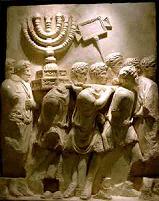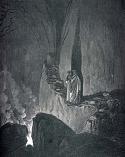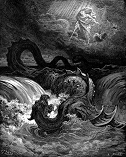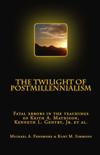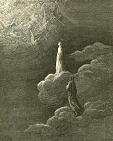Commentary on Daniel Chapter Twelve
The Great Tribulation and Time of Resurrection
Daniel’s vision concerning what would
befall his people in the latter days concludes with the
appearance of Christ, a time of universal trouble consisting in
the persecution under Nero, the Roman civil wars, and
destruction of the Jewish state, followed by the resurrection of
the dead.
Christ as Michael
1 – And at that time shall Michael stand
up, the great prince which standeth for the children of thy
people:
Michael should be understood as Christ.[1]
Instances in which we encounter this name show that it
describes a manifestation of the divinity when acting in a
military context as the great captain of God’s people.
(See comments at Dan.
A third reference to the Archangel (without
naming him as Michael) occurs in the context of Christ’s second
coming (I Thess. 4:16),
where the “voice of the archangel” and “trump of God” are used
alternately to describe the shout of the Lord at his descent to
save his people and raise the dead.
This should be compared with Jn.
In the New Testament, Michael’s battle on
behalf of his people is portrayed under the imagery of
Armageddon and Gog and Magog (Rev. 16:16;
20:8, 9),
a symbolic description of the tribulation under Nero Caesar,
when the persecuting power of the Roman government (the “dragon”
and “beast”) would be loosed for the battle of the great day of
God Almighty (Rev. 16:14).
The persecution ends by the coming of Christ, who
destroys Nero and the persecutors with the “brightness of his
coming” and “the spirit of his mouth” (II Thess. 2:8;
Rev. 20:9).
That is the context here.
The vision thus advances from the establishment of the
Roman power in the land to the coming of Christ’s kingdom in
power in vengeance upon his enemies and vindication of his
gospel.
The Universal Time of Trouble
and there shall be a time of trouble, such as never was since there was a nation even to that same time:
The nation’s ultimate crisis was part of a
larger time of divine wrath that would overtake the world.
Paul told the Athenians God was about to judge the world
in righteousness by Jesus Christ (Acts
The church, too, went through a time of
testing.
In Pilate’s absence, Vitellius appointed
Marcellus procurator.
At this same time, Vitellius removed Caiaphas from the
High Priesthood in apparent response to a petition from the
Jews, perhaps owing to unrest the persecution caused in the
land.[3]
Before Pilate arrived in
In consideration of Agrippa’s efforts,
Claudius expanded his kingdom, making him king over all the
realm of
This protection of law—the religio
licita—extended throughout the empire during Claudius’
reign. It also obtained in the early years of Nero, when Burrus
and Seneca, the tutors and guardians of the emperor’s youth,
were able to control him.
Revelation portrays the protection afforded the church
during this period when it describes the dragon and beast being
bound in the bottomless pit (Rev. 11:7;
17:8;
20:1-3).
This same time is alluded to by St. Paul in II
Thessalonians, when he says that the “mystery of iniquity”
(murderous hatred for the church and gospel) was then
restrained, but would soon break out in the persecution under
the man of sin (II Thess. 2:3-8;
see also comments at Dan. 11:36).
Nero’s need for a scapegoat upon which to blame the
burning of Rome launched the first imperial persecution, the
loosing of the dragon and beast from the pit to rise up and
persecute the church anew.
Judging from the book of Revelation and
many of the Lord’s parables, the great spiritual battle of the
last day witnessed the almost universal martyrdom of the church
as the saints and confessors were called upon to lay down their
lives in testimony of Christ.
It was with a view to the eschatological day that the
John the Baptist said:
“And now also the axe is laid unto the
root of the trees: therefore every tree which bringeth not forth
good fruit is hewn down, and cast into the fire. I indeed
baptize you with water unto repentance: but he that cometh after
me is mightier than I, whose shoes I am not worthy to bear: he
shall baptize you with the Holy Ghost, and with fire: Whose fan
is in his hand, and he will throughly purge his floor, and
gather his wheat into the garner; but he will burn up the chaff
with unquenchable fire” (Matt. 3:10-13).
The chaff was gathered up and burned in the
war with
“And I looked, and behold a white cloud,
and upon the cloud one sat like unto the Son of man, having on
his head a golden crown, and in his hand a sharp sickle. And
another angel came out of the temple, crying with a loud voice
to him that sat on the cloud, Thrust in thy sickle, and reap:
for the time is come for thee to reap; for the harvest of the
earth is ripe. And he that sat on the cloud thrust in his sickle
on the earth; and the earth was reaped” (Rev. 14:9-16).
John describes saints and confessors that
sufferedd under Nero elsewhere, saying:
“And after this I beheld, and, lo, a
great multitude, which no man could number, of all nations, and
kindreds, and people, and tongues, stood before the throne, and
before the Lamb, clothed with white robes, and palms in their
hands... “And one of the elders answered, saying unto me, What
are these which are arrayed in white robes? and whence came
they? And I said unto him, Sir, thou knowest. And he said to me,
These are they which came out of the great tribulation (Gk. tas
thlipseos tas megalas), and have washed their robes, and made
them white in the blood of the Lamb” (Rev. 7:9-14).
and at that time thy people shall be
delivered, every one that shall be found written in the book.
Christ would deliver his people by the
terrible judgments meted out at the eschaton; as the political
fabric of
The kingdom and resurrection were
contemporaneous; possessing the kingdom and dominion upon earth
occurred at the same time the dead received the inheritance in
heaven.
Paul makes this clear in his epistle to Timothy: “I
charge thee therefore before God, and the Lord Jesus Christ, who
shall judge the quick and the dead at his appearing and his
kingdom” (II Tim. 4:1).
Matthew’s gospel is to the same effect: “For the Son of
man shall come in the glory of his Father with his angels; and
then he shall reward every man according to his works.
Verily I say unto you, There be some standing here, which
shall not taste of death, till they see the Son of man coming in
his kingdom” (Matt.
|
Daniel’s “Time of Trouble” “The Great Tribulation” a.d. 64 – 70
64
65
66
67
68
69
70 |
The fact that some of the apostles would be
alive at Christ’s coming and witness the advent of his kingdom
and the resurrection (though unseen to eye of man) accords
perfectly with Daniel’s statements here, placing these events in
the time of Nero and the fall of
The General Resurrection
2 – And many of them that sleep in the dust of the earth shall awake, some to everlasting life, and some to shame and everlasting contempt.
Jesus showed the nearness of this passage’s
fulfillment when he said, “Verily, verily, I say unto you, The
hour is coming, and now is, when the dead shall hear the
voice of the Son of God: and they that hear shall live” (Jn.
5:25).
Jesus here refers to those whome he would raise during
his earthly ministry, which stood in token of his divinity and
the imminence of the general resurrection.
Hence, in Jn.
Use of the term “many” by Daniel does not
argue against the application of this passage to all; the idea
is that the multitudes in Hades would awake, not just
some.[8]
If there were any question, Jesus’ quotation of this
passage dispels the idea that anything other than the general
resurrection was in view.
Jerome admits that this passage refers to the general
resurrection, and not to a metaphoric or spiritualized
resurrection as Porphyry and others have tried to suggest.
Porphyry attempted to apply all these verses to Antiochus
Epiphanes, causing Jerome to comment, “Up until this point
Porphyry somehow managed to maintain his position and impose
upon the credulity of the naïve among our adherents as well as
the poorly educated among his own.
But what can he say of this chapter, in which is
described the resurrection of the dead, with one group being
revived for eternal life and the other group for eternal
disgrace?”[9]
Although he recognizes that the general resurrection is
in view, Jerome avoids the obvious context and time for
fulfillment of these verses by transporting them across the
centuries. How
curious it must strike the student of scripture to learn that
the very minute progression of historical events, allowing us to
identify the succession of monarchs from the time of the
Persians unto the rise of Rome, should suddenly and without
notice skip millennia ahead to the world’s purported end,
creating a rent in the fabric of scripture thousands of years
wide and still growing!
Yet, the angel clearly states that all these events would
be fulfilled when the Jewish nation and polity was destroyed
(Dan. 12:7).
It is only by the greatest violence to the context that
these verses can be wrested from their place in history.
The chief objection to past fulfillment of
these verses is a mistaken conception regarding the nature of
the resurrection.
When the passage states that “those who sleep in the dust of the
earth shall awake,” it does not intend to imply the resurrection
of physical bodies.
The language is figurative.
“Sleeping” is an accommodative term used to describe the
condition of physical death and the rest of the soul in Hades.
(See I Cor. 15:18, 20; I
Thess.
Revelation also depicts the dead as
conscious (Rev. 6:9, 10;
20:4),
and Moses who died and Elijah who was translated were both alive
and appeared on the mount of transfiguration (Matt. 17:1-13).
This is also the clear import of our Lord’s words in
Matt. 22:31, 32,
when he said that Abraham, Isaac, and Jacob were partakers of
the first resurrection of the soul in Hades: “But as touching
the resurrection of the dead, have ye not read that which was
spoken unto you by God, saying, I am the God of Abraham, and the
God of Isaac, and the God of Jacob?
God is not the God of the dead, but of the living.”[10]
Thus, Abraham and the patriarchs were presently
living; resurrection (the first resurrection) was a
present fact, though the eternal inheritance in heaven at
the general resurrection was yet future.
So much for the fact of the resurrection; in the
same passage, Jesus sets forth its nature when he says
that “in the resurrection they neither marry, nor are given in
marriage, but are as the angels of God in heaven” (Matt.
The Pharisees’ misconception (doubtless it
is their teaching the Sadducees were attempting to refute by
their question to the Lord) had it that the resurrection was of
physical bodies upon earth, and therefore assumed that marriage
would be part of resurrection life.
However, Jesus shows that the resurrection is of the
spirit in heaven, for men will then be as angels that do not
have physical bodies, but are immaterial, intangible, and
invisible. Paul
agrees, saying, that the “body thou sowest, thou sowest not that
body that shall be” and “flesh and blood cannot inherit the
kingdom of heaven” (I Cor.
3 – And they that be wise shall shine as
the brightness of the firmament; and they that turn many to
righteousness as the stars for ever and ever.
In Dan. 8:10, Antiochus
is portrayed as trampling the host of heaven to the ground,
which we understood in reference to his oppression of the Jews.
Here the stars of the firmament point to those who obeyed
the gospel and became heralds of righteousness.
Paul called the Philippians “sons of God, without rebuke,
in the midst of a crooked and perverse nation, among whom ye
shine as lights in the world; holding forth the word of life”
(Phil.
4 – But thou, O Daniel, shut up the
words, and seal the book, even to the time of the end;
Isaiah used similar imagery to describe the
blindness of the peoples’ heart, and how the warning of his
visions fell upon deaf ears. “And the vision of all is become
unto you as the words of a book that is sealed, which men
deliver to one that is learned, saying, Read this, I pray thee:
and he saith, I cannot; for it is sealed” (Isa. 29:11).
In a similar manner, Daniel is told to shut up the book,
and seal the words; the message was to remain unclear and
obscure until the time neared for its fulfillment, some
five-hundred years away.
(Cf. Dan. 8:26.)
John, on the other hand, was told “seal not the
sayings of the prophecy of this book: for the time is at hand”
(Rev. 22:10).
Obviously, this militates entirely against the idea that
John’s message belongs to our day or some future time.
If Daniel’s message was to be laid up because it belonged
to a time 500 years away, how can John’s message, which he was
told not to seal, belong to a time 2000 years away?
Moreover, since Revelation is but an expansion upon and
fulfillment of Daniel, the fact John was told not to seal the
book is certain evidence that the sealed portions of Daniel were
opened in the Apocalypse and subsequently fulfilled.
many shall run to and fro, and knowledge
shall be increased.
As the end approached, God would help his
people understand the meaning and import of the visions of the
book so that what was “sealed” would become “open.”
We see this fulfilled in the days of John, when all the
people mused in their hearts whether he was Christ and
multitudes flocked to
“Whereas the war which the Jews made
with the Romans hath been the greatest of all those, not only
that have been in our times, but, in a manner, of those that
ever were heard of; both of those wherein cities have fought
against cities, or nations against nations.”[11]
5, 6 – Then I Daniel looked, and,
behold, there stood other two, the one on this side of the bank
of the river, and the other on that side of the bank of the
river. And one said to
the man clothed in linen, which was upon the waters of the
river, How long shall it be to the end of these wonders?
Two additional angels now appear for the
specific purpose of eliciting information necessary for
completion of the vision and its message.
“How long shall it be to the end of these wonders?”
In other words, what are the limits of the vision and how
can it be known it has been fulfilled?
Surely, if the end of the cosmos was in view, this
question would be superfluous, for such could not be mistaken.
But if something less than the end of history is in
view—events like the coming of Christ and resurrection of the
dead—then the question makes perfect sense.
How could men know for certain that Christ was indeed
come and the dead raised?
What sign would heaven provide to convince men of these
things?
7 – And I heard the man clothed in
linen, which was upon the waters of the river, when he held up
his right hand and his left hand unto heaven, and sware by him
that liveth for ever
This should be compared to the Song of
Moses, reciting the vengeance laid up in store against the
sinful nation: “To
me belongeth vengeance, and recompence; their foot shall slide
in due time: for the day of their calamity is at hand, and the
things that shall come upon them make haste.
For the Lord shall judge his people, and repent himself
for his servants, when he seeth that their power is gone, and
there is none shut up, nor left….For I lift up my hand to
heaven, and say, I live for ever” (Deut. 32:35-40).
Here, we find the Lord swearing by himself
that he would accomplish the destruction of the Jewish people in
language tracking exactly that of the present verse.
“When he seeth their power is gone” answers the following
clause, which declares that the “scattering of the power” of the
holy people—the Jews—would signify the fulfillment of the
vision. The identity of language and content confirms the
parameters of the instant vision and its terminus at the
fall of
The “very little while” of Hebrews becomes still shorter in Revelation, where another angel lifts his hand to heaven and swears “there shall be time no more” (viz., no more delay) (Rev. 10:6). Following this declaration is the persecution of the saints (“two witnesses”), in which their dead bodies lay exposed for “three days and a half” (viz., three years and a half—the length of the persecution under Nero). This, in turn, is followed by the great city, Jerusalem (“spiritually called Sodom and Egypt, where also our Lord was crucified”), being trodden under foot by the Gentiles for forty-two months (Rev. 11:2, 8, 9; cf. Lk. 21: 24), and the declaration of heaven that “the kingdoms of the world are become the kingdoms of our Lord and of his Christ, and he shall reign forever and ever” (Rev. 11:15).
Finally, and what proves that the
resurrection would occur at the fall of
“And the nations were angry, and thy
wrath is come, and the time of the dead, that they should be
judged, and that thou shouldest give reward unto thy servants
the prophets, and to the saints, and them that fear thy name,
small and great; and shouldest destroy them which destroy the
earth” (Rev. 11:18;
cf. Matt. 16:27, 28; II Tim.
4:1).
The common factor in all of these passages
is the fall of
Worldwide Judgment and the End of the
Jewish Polity
that it shall be for a time, times, and an half; and when he shall have accomplished to scatter the power of the holy people,
In Daniel 9:24-27,
490 prophetic years are set out, marking the period until coming
of Christ and end of the Jewish nation.
Four hundred eighty-three years are fulfilled from
Nehemiah until the baptism of Christ (454 B.C.—A.D. 29).
The first half of the remaining week was fulfilled in the
earthly ministry of Christ, who was “cut off’ in the midst of
the final week (v. 26).
However, the second half of the final week is nowhere
expressly spelled out.
We would suggest that the final three and a half years
are alluded to here in the “time, times, and an half” time
mentioned by the angel.
It is clear these three and a half years are tied to the
war with
The same events are described in chapter
nine, where, following Christ’s ministry, the desolation of the
city and sanctuary is described (vv. 26, 27).
Since the same events are described, the period in which
they were to be fulfilled must apply equally to both.
Rev. 11:2
should also be added in witness; the forty-two months John said
the holy city would be trodden under foot by the Gentiles
corresponds with the three and a half years mentioned here.
The war with
all these things shall be finished.
It should be emphasized that “all things
finished” included the resurrection of the souls in Hades and
the general judgment, as shown by verse two.
Christ was to put all enemies beneath his feet.
His triumph over the Jews and Romans was accomplished in
the events beginning with his ascension and ending in A.D. 70.
The
last enemy was Hadean death.
Christ defeated sin in his cross, but Hades remained to
be destroyed as the final obstacle keeping men from the presence
of God in heaven.
Jesus thus promised that the gates of Hades would not prevail
against his church (Matt.
8 – And I heard, but I understood not:
then said I, O my Lord, what shall be the end of these things?
The angel has already declared that the end
of these things would be marked by the fall of
9 – And he said, Go thy way, Daniel: for
the words are closed up and sealed till the time of the end.
To get a sense of how the book was closed
up and sealed, one need only observe the befuddled comprehension
of futurists today, who see in its pages a historical succession
of events until earth’s end.
Prepossessed with ideas of their own imaging, the book is
closed to their understanding.
In the same way, the Jews, prepossessed with the idea
that the Messiah would establish an earthly kingdom setting them
at the apex of world power, missed completely the coming of
Christ and actually murdered the Savior.
10 – Many shall be purified, and made
white, and tried; but the wicked shall do wickedly: and none of
the wicked shall understand; but the wise shall understand.
The ensuing centuries, from the Babylonian
captivity until
The Continuous Offering for Caesar and
11, 12 – And from the time that the
daily sacrifice shall be taken away, and abomination that maketh
desolate set up, there shall be a thousand two hundred and
ninety days.
Blessed is he that waiteth, and cometh to the thousand three
hundred and five and thirty days.
There are two basic approaches to these
verses. One holds
that they represent a recapitulation to Antiochus Epiphanes and
his desecration of the temple; the other places them at the fall
of
According to this view then, the 1290 days were fulfilled in the period from the fifteenth of Casleu 168 B.C. to the cleansing of the temple on the twenty-fifth of Casleu 165 B.C.; and the 1335 days was fulfilled in the supposed death of Antiochus forty-five days later. However, it takes only a cursory glance at these dates to see that they are impossible. The period from the taking away of the sacrifice until the temple was cleansed was only three years and ten days, or thirty-six months. But 1290 days is forty-three months. Hence, there is fully seven months difference between them. Moreover, Antiochus died in the 149th year of the Greeks (164 B.C.),[15] but the temple was cleansed in the 148th (165 B.C.) in the month Casleu, which answers to our December. The Greek new year began in the spring (Nisan/April).[16] Hence, the 149th year of the Greeks would not have begun for three months after cleansing the temple, making impossible to bring Antiochus’ death within the forty-five day window proposed.[17]
As already shown, the abomination of
desolation refers, not to the erection of an idol in the temple,
but to the desolations wrought by invading foreign armies.
(See comments at
The Jews’ war with
The next day was the festival Xylophory;
and the following day he gives as the fifteenth of Ab.[19]
Reckoning backward from this date, and assuming four days
elapsed in sending to Agrippa and the arrival of the soldiers in
Prior to his investment of
Josephus does not tell us when Titus
arrived at
Against this interpretation is the fact
that the “daily sacrifice” is generally understood in reference
to the morning and evening sacrifice commanded in the
law, not the offering of Caesar or those of the Gentiles (Num.
28, 29).
The Hebrew term is tamiyd, and properly signifies
regular or continuous.
The same term occurs in Dan. 11:31 and
|
1,335 Days from Taking Away Caesar’s
Continuous Sacrifice Until Titus’ Investment of
66 67 68 69 70 |
The shew bread, too, was to be continuously
(tamiyd) present before the Lord (Lev. 24:8;
Num. 4:7;
II Chron. 2:4),
as were also the candlestick and incense (Ex. 30:7, 8;
Lev. 24:2-4).
Thus, reference to the sacrifice for Caesar and
“But the people of the church in
13 – But go thy way till the end be: for
thou shalt rest, and stand in thy lot at the end of the days.
The end of the days is not the 1335 days
that marked the commencement of the siege, but the time, times,
and a half (forty-two months, 1260 days) that witnessed the
city’s destruction.
With all earthly enemies firmly beneath his feet, the last enemy
(Hadean death) would be destroyed, and the righteous dead
receive their eternal inheritance in heaven, of which Daniel was
promised a part.
[1] “I embrace the opinion of those who refer this to the person of Christ.” Calvin, in loc.
[2] We interpret the
“body of Moses” in reference to the Jewish nation
inasmuch as they were baptized unto Moses in the cloud
and in the sea (I Cor. 10:1, 2),
just as Christians are made members of the body of
Christ by baptism (I Cor.
[3] Josephus, Antiquities, XVIII, iv, 2, 3
[4] Ibid, XVIII, vi, 10; XVIII, vii, 2
[5] Ibid, XVIII, vi, 10
[6] Ibid, XIX, iii, iv, v, 1
[7] Ibid, XIX, ix, 1, 2
[8] “We cannot deduce that ‘many’ here excludes ‘all.’ The idea suggested is rather multitudinousness.” J. E. H. Thomson, The Pulpit Commentary, in loc.
[9] Jerome, in loc.
[10] Greco-Roman notions of Hades had it that the dead resided there a thousand years before being reborn to earthly life. (Plato, Republic, Bk. X, 315-320, Virgil, Aeneid, Bk. VI, 734ff; Justin Martyr, 1st Apology, VIII, The Works of Voltaire. A Contemporary Version. A Critique and Biography by John Morley, notes by Tobias Smollett, trans. William F. Fleming (New York: E.R. DuMont, 1901). In 21 vols. Vol. 3. Chapter: APOCALYPSE.) This appears to be the meaning of the symbolic thousand year periods in Rev. 20:1-3, and 4-6; viz., the dragon, having received a mortal wound in the collapse of the persecution over Stephen, was figuratively bound in Tartarus until the persecution under Nero, and the martyrs, having died under Nero, reigned with Christ in Paradise pending the general resurrection. See the author’s article Revelation’s Millennia and Greco-Roman Notions of Hades.
[11] Josephus, Wars, Preface, 1; cf. V, x, 5
[12] Josephus, Wars, VI, ix, 2
[13] I Macc. 1:54
[14] I Macc.
[15] I Macc. 6:19
[16] Ussher, § 3428, p. 444; Finegan, § 194, p. 103
[17] For examples of this approach, see Moses Stuart in loc; Philip Desprez, pp. 167-168; Josephus,
Antiquities X, xi, 7
[18] Ibid II, xvii, 2
[19] Ibid, II, xvii, 2, 5, 6, 7
[20] Ibid, V, iii, 1, 5; VI, xiii, 7
[21] Ibid, IV, xi, 5;
V, i, 1; cf.
[22] Ibid, IV, xi, 5
[23] Ibid
[24] We have used
Titus’ departure from
[25] Josephus, Wars, II, x, 4
[26] Eusebius,
Ecclesiastical History,
To receive Kurt Simmons’ e-mail newsletter, The Sword & The Plow, click the Subscribe link:
All rights reserved.
